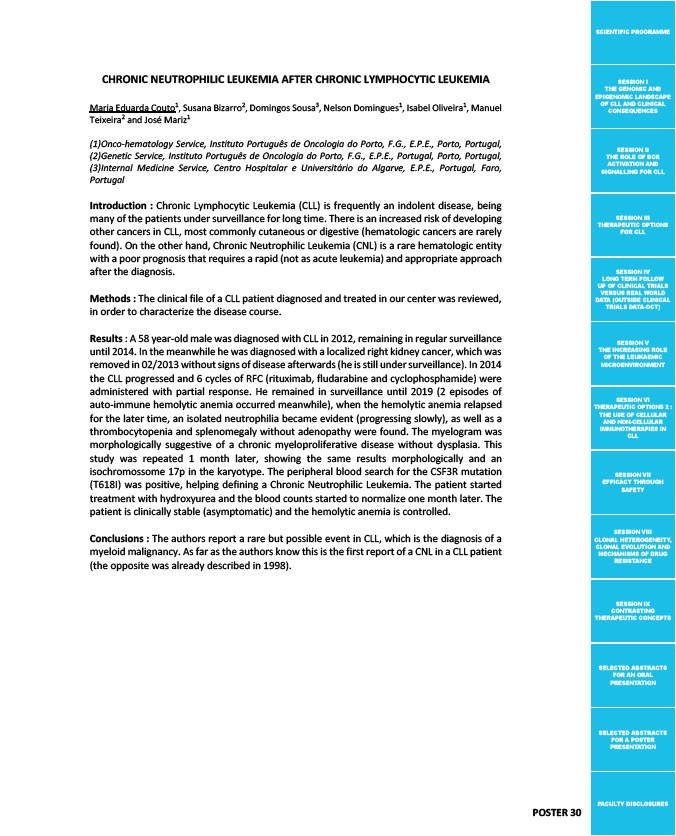
SCIENTIFIC PROGRAMME
SESSION I
THE GENOMIC AND
EPIGENOMIC LANDSCAPE
OF CLL AND CLINICAL
CONSEQUENCES
SESSION II
THE ROLE OF BCR
ACTIVATION AND
SIGNALLING FOR CLL
SESSION III
THERAPEUTIC OPTIONS
FOR CLL
SESSION IV
LONG TERM FOLLOW
UP OF CLINICAL TRIALS
VERSUS REAL WORLD
DATA (OUTSIDE CLINICAL
TRIALS DATA-OCT)
SESSION V
THE INCREASING ROLE
OF THE LEUKAEMIC
MICROENVIRONMENT
SESSION VI
THERAPEUTIC OPTIONS 2 :
THE USE OF CELLULAR
AND NON-CELLULAR
IMMUNOTHERAPIES IN
CLL
SESSION VII
EFFICACY THROUGH
SAFETY
SESSION VIII
CLONAL HETEROGENEITY,
CLONAL EVOLUTION AND
MECHANISMS OF DRUG
RESISTANCE
SESSION IX
CONTRASTING
THERAPEUTIC CONCEPTS
SELECTED ABSTRACTS
FOR AN ORAL
PRESENTATION
SELECTED ABSTRACTS
FOR A POSTER
PRESENTATION
FACULTY DISCLOSURES
CHRONIC NEUTROPHILIC LEUKEMIA AFTER CHRONIC LYMPHOCYTIC LEUKEMIA
Maria Eduarda Couto1, Susana Bizarro2, Domingos Sousa3, Nelson Domingues1, Isabel Oliveira1, Manuel
Teixeira2 and José Mariz1
(1)Onco-hematology Service, Instituto Português de Oncologia do Porto, F.G., E.P.E., Porto, Portugal,
(2)Genetic Service, Instituto Português de Oncologia do Porto, F.G., E.P.E., Portugal, Porto, Portugal,
(3)Internal Medicine Service, Centro Hospitalar e Universitário do Algarve, E.P.E., Portugal, Faro,
Portugal
Introduction : Chronic Lymphocytic Leukemia (CLL) is frequently an indolent disease, being
many of the patients under surveillance for long time. There is an increased risk of developing
other cancers in CLL, most commonly cutaneous or digestive (hematologic cancers are rarely
found). On the other hand, Chronic Neutrophilic Leukemia (CNL) is a rare hematologic entity
with a poor prognosis that requires a rapid (not as acute leukemia) and appropriate approach
after the diagnosis.
Methods : The clinical file of a CLL patient diagnosed and treated in our center was reviewed,
in order to characterize the disease course.
Results : A 58 year-old male was diagnosed with CLL in 2012, remaining in regular surveillance
until 2014. In the meanwhile he was diagnosed with a localized right kidney cancer, which was
removed in 02/2013 without signs of disease afterwards (he is still under surveillance). In 2014
the CLL progressed and 6 cycles of RFC (rituximab, fludarabine and cyclophosphamide) were
administered with partial response. He remained in surveillance until 2019 (2 episodes of
auto-immune hemolytic anemia occurred meanwhile), when the hemolytic anemia relapsed
for the later time, an isolated neutrophilia became evident (progressing slowly), as well as a
thrombocytopenia and splenomegaly without adenopathy were found. The myelogram was
morphologically suggestive of a chronic myeloproliferative disease without dysplasia. This
study was repeated 1 month later, showing the same results morphologically and an
isochromossome 17p in the karyotype. The peripheral blood search for the CSF3R mutation
(T618I) was positive, helping defining a Chronic Neutrophilic Leukemia. The patient started
treatment with hydroxyurea and the blood counts started to normalize one month later. The
patient is clinically stable (asymptomatic) and the hemolytic anemia is controlled.
Conclusions : The authors report a rare but possible event in CLL, which is the diagnosis of a
myeloid malignancy. As far as the authors know this is the first report of a CNL in a CLL patient
(the opposite was already described in 1998).
POSTER 30